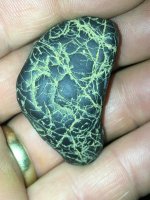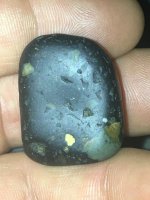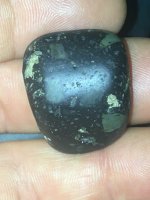You are using an out of date browser. It may not display this or other websites correctly.
You should upgrade or use an alternative browser.
You should upgrade or use an alternative browser.
Help with identifying if possible meteorites!
- Thread starter EDavis
- Start date
EDavis
Jr. Member
- Aug 30, 2021
- 64
- 220
- Primary Interest:
- All Treasure Hunting
- Thread starter
- #2
Posted pictures before typing any info. I dug these from the yard. Both have magnetism not so much as the first pictured. The first one I did do a scratch test on ceramic which didn’t leave a streak. The odd colors are neat. The second one is just crusted looking but has more magnetism. It will barely stay on magnet and the first one will slightly move if laid flat.
- Jan 30, 2013
- 581
- 1,204
- Detector(s) used
- Whites
- Primary Interest:
- All Treasure Hunting
cut then in half with a tile saw and post photos, cutting won't effect the value.
traveller777
Gold Member
- Aug 20, 2017
- 5,435
- 17,432
- Detector(s) used
- Minelab CTX 3030 & Explorer
- Primary Interest:
- All Treasure Hunting
Thanks for sharing. I do not know if meteorites, but I like the way the first one looks. There are several meteorite folks here so sure they will help you out when they come along.
Red-Coat
Gold Member
I don't think there's any need to cut those in half to check if they are meteorites. Sadly they aren't and have no features to suggest that they might be. Quite the opposite in fact.
Emil W
Sr. Member
- Nov 4, 2021
- 476
- 1,087
- Detector(s) used
-
Deus 2
Deus
Deus Lite
Garrett Apex
Garrett Pinpointer
BH Discovery 2200
BH Pioneer EX
White's Coinmaster 6000D (have had for decades)
- Primary Interest:
- Metal Detecting
Definitely not meteorites, sorry. But if they were meteorites cutting them in half will detract from the 'value' to some collectors, myself included, although by value I don't necessarily mean monetary value. You may be able to sell a cut meteorite for the same price as a whole one but it will lower the appeal to a large segment of the market.
EDavis
Jr. Member
- Aug 30, 2021
- 64
- 220
- Primary Interest:
- All Treasure Hunting
- Thread starter
- #7
Thanks for information, is it common to have magnetism in some rocks. The first stone didn’t leave any streak on the back side of tile and has slight magnetic properties. It is also very tough stone. Any other ideas of what it could also be.I don't think there's any need to cut those in half to check if they are meteorites. Sadly they aren't and have no features to suggest that they might be. Quite the opposite in fact.
- Jan 30, 2013
- 581
- 1,204
- Detector(s) used
- Whites
- Primary Interest:
- All Treasure Hunting
I just got one approved, they have to cut it to get approved.Thanks for information, is it common to have magnetism in some rocks. The first stone didn’t leave any streak on the back side of tile and has slight magnetic properties. It is also very tough stone. Any other ideas of what it could also be.
- Dec 30, 2012
- 7,446
- 14,013
- 🏆 Honorable Mentions:
- 2
- Detector(s) used
- Presently using Deus 2's & have Minelabs, Nokta's Tesoro's DEus's Have them all . Have WAY to many need to get rid of some
- Primary Interest:
- All Treasure Hunting
Arnt most meteorites
MAGNETIC ?
MAGNETIC ?
Red-Coat
Gold Member
Many common rocks have at least some attraction to a magnet. Native iron is a rare terrestrial material and only found in particular locations, but anything having significant amounts of the iron oxide mineral magnetite can be strongly magnetic. Usually such rocks are principally hematite with secondary magnetite and will leave a characteristic red/brown streak on a porcelain tile though.
Weaker magnetic attraction is a common property of a wider variety of rocks (many of which will leave no streak), notably those in the basalt family, from minor amounts of magnetite plus minerals such as ilmenite or ulvöspinel (both iron-titanium oxides). I don’t think it can reliably said what your rocks are without close examination in hand, but (for example) these are basaltic pebbles (picture is copyrighted, so I am only providing a link):
If you Google the term you’ll see lots of other examples. Weird marks like those on your first rock can arise in all kinds of ways… from shrinkage during cooling of igneous rocks, from invasion or differential crystallisation of secondary minerals as web-like veins which then erode from the host rock during water transport and from surface scarring during glacial or glacial meltwater transport of cobble and pebble-sized rocks. Those kinds of marks are absolutely not characteristic of meteorites though.
It’s true that most meteorites are attracted to a magnet but because that only applies to “most” it’s not a conclusive test. Some chondrite meteorites in the ‘LL’ class (Low total metal/Low native metal) are only barely attracted to a strong magnet, carbonaceous chondrites usually not attracted, and stony achondrites rarely attracted (but never strongly so). However, what can be said with 100% certainty is that if a rock has a metallic appearance or exhibits any veins or flecks of metal and is not attracted to a magnet then it isn’t a meteorite.
A meteorite doesn’t have to be cut to confirm it as such, and certainly doesn’t need to be cut in half. There are many non-destructive tests (or at least which leave minimal noticeable marks) that an expert laboratory can perform for confirmation. Cutting is however usually necessary for typology classification. Even then, a small ‘window’ is usually all that is needed, not a full cut through the specimen.
Weaker magnetic attraction is a common property of a wider variety of rocks (many of which will leave no streak), notably those in the basalt family, from minor amounts of magnetite plus minerals such as ilmenite or ulvöspinel (both iron-titanium oxides). I don’t think it can reliably said what your rocks are without close examination in hand, but (for example) these are basaltic pebbles (picture is copyrighted, so I am only providing a link):
If you Google the term you’ll see lots of other examples. Weird marks like those on your first rock can arise in all kinds of ways… from shrinkage during cooling of igneous rocks, from invasion or differential crystallisation of secondary minerals as web-like veins which then erode from the host rock during water transport and from surface scarring during glacial or glacial meltwater transport of cobble and pebble-sized rocks. Those kinds of marks are absolutely not characteristic of meteorites though.
It’s true that most meteorites are attracted to a magnet but because that only applies to “most” it’s not a conclusive test. Some chondrite meteorites in the ‘LL’ class (Low total metal/Low native metal) are only barely attracted to a strong magnet, carbonaceous chondrites usually not attracted, and stony achondrites rarely attracted (but never strongly so). However, what can be said with 100% certainty is that if a rock has a metallic appearance or exhibits any veins or flecks of metal and is not attracted to a magnet then it isn’t a meteorite.
A meteorite doesn’t have to be cut to confirm it as such, and certainly doesn’t need to be cut in half. There are many non-destructive tests (or at least which leave minimal noticeable marks) that an expert laboratory can perform for confirmation. Cutting is however usually necessary for typology classification. Even then, a small ‘window’ is usually all that is needed, not a full cut through the specimen.
Red-Coat
Gold Member
Dang... that link above refuses to post. Try the Amazon UK site https://www.amazon.co.uk/
and add this to the link:
Quarrystore-Basalt-Decorative-Garden-Pebbles/dp/B076NZK5YN
and add this to the link:
Quarrystore-Basalt-Decorative-Garden-Pebbles/dp/B076NZK5YN
EDavis
Jr. Member
- Aug 30, 2021
- 64
- 220
- Primary Interest:
- All Treasure Hunting
- Thread starter
- #12
Many common rocks have at least some attraction to a magnet. Native iron is a rare terrestrial material and only found in particular locations, but anything having significant amounts of the iron oxide mineral magnetite can be strongly magnetic. Usually such rocks are principally hematite with secondary magnetite and will leave a characteristic red/brown streak on a porcelain tile though.
Weaker magnetic attraction is a common property of a wider variety of rocks (many of which will leave no streak), notably those in the basalt family, from minor amounts of magnetite plus minerals such as ilmenite or ulvöspinel (both iron-titanium oxides). I don’t think it can reliably said what your rocks are without close examination in hand, but (for example) these are basaltic pebbles (picture is copyrighted, so I am only providing a link):
If you Google the term you’ll see lots of other examples. Weird marks like those on your first rock can arise in all kinds of ways… from shrinkage during cooling of igneous rocks, from invasion or differential crystallisation of secondary minerals as web-like veins which then erode from the host rock during water transport and from surface scarring during glacial or glacial meltwater transport of cobble and pebble-sized rocks. Those kinds of marks are absolutely not characteristic of meteorites though.
It’s true that most meteorites are attracted to a magnet but because that only applies to “most” it’s not a conclusive test. Some chondrite meteorites in the ‘LL’ class (Low total metal/Low native metal) are only barely attracted to a strong magnet, carbonaceous chondrites usually not attracted, and stony achondrites rarely attracted (but never strongly so). However, what can be said with 100% certainty is that if a rock has a metallic appearance or exhibits any veins or flecks of metal and is not attracted to a magnet then it isn’t a meteorite.
A meteorite doesn’t have to be cut to confirm it as such, and certainly doesn’t need to be cut in half. There are many non-destructive tests (or at least which leave minimal noticeable marks) that an expert laboratory can perform for confirmation. Cutting is however usually necessary for typology classification. Even then, a small ‘window’ is usually all that is needed, not a full cut through the specimen.
Thank you for the info..sounds like you are very knowledgeable. I will look into the rocks mentioned.
Back-of-the-boat
Gold Member
- Apr 18, 2013
- 6,886
- 8,507
- Detector(s) used
- AT GOLD/Garrett /C.Scope cs4PI/Garrett(carrot) pro pointer/ 5x8 double d coil and sniper coil/Lesche digger/Lesche "T" handle shovel.
- Primary Interest:
- All Treasure Hunting
Maybe coprolite, don't know but a possibility.
Chilli
Hero Member
If I found anything that looked like that, I wouldn't care where it came from, I'd be over the moon, pun not intended. Great find! 👍
Nate in Ga
Sr. Member
there cool hold onto em
Graphicbadger92
Greenie
- Apr 13, 2021
- 16
- 16
- Detector(s) used
- Sharp shooter 2, hand held detectors
- Primary Interest:
- All Treasure Hunting
Nice iv found similar rocks that test as jade on my presidium gemtester2 . If it helps any they are identical .all but the size is exact same
hardness ,scratch test and color too , from what info we have been provided I have cuts of mine I cut a few days ago . Iv many Jeremy jade items in my piles of gem rough .
hardness ,scratch test and color too , from what info we have been provided I have cuts of mine I cut a few days ago . Iv many Jeremy jade items in my piles of gem rough .
Graphicbadger92
Greenie
- Apr 13, 2021
- 16
- 16
- Detector(s) used
- Sharp shooter 2, hand held detectors
- Primary Interest:
- All Treasure Hunting
I’ll go get a few pieces to see what cut is like. if your not able to cut it . If clear should shape it with proper shaping compound it might turn clear once past the outer rough layer of scratches and damaged areas . At the least you will have a polished stone if not a gemstone . Perfect for wrapping or jewelry. Many jewelers would take a liking to that few stones you have . Maybe ask your local jeweler he has a presidium tester I’m sure . Could tell you exactly what it is .
Top Member Reactions
-
 2375
2375 -
 1134
1134 -
 1061
1061 -
 885
885 -
 826
826 -
 801
801 -
 768
768 -
 747
747 -
 610
610 -
 506
506 -
 497
497 -
 474
474 -
 468
468 -
 425
425 -
 396
396 -
 376
376 -
O
372
-
 368
368 -
 366
366 -
 364
364
Users who are viewing this thread
Total: 2 (members: 0, guests: 2)
Latest Discussions
-
Seven Diamond Anniversary Ring Emerged From a Lake 12 Years Ago
- Latest: TheInspector
-
-
-









